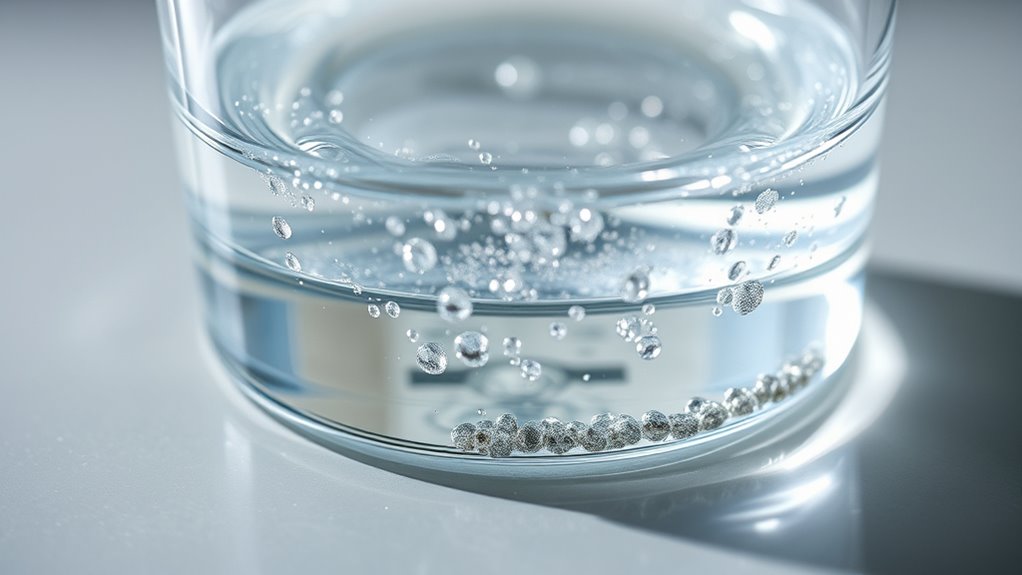Heavy metals like lead, arsenic, and mercury are toxic pollutants that can contaminate your water through natural deposits, industrial processes, or waste disposal. They pose serious health risks, including neurological damage, cancer, and other illnesses. These metals can build up in your body over time, especially affecting vulnerable groups like children and pregnant women. Understanding how they get into your water and their dangers can help you protect yourself—exploring more will give you practical ways to stay safe.
Key Takeaways
- Heavy metals like lead, arsenic, and mercury are toxic elements found naturally or through human activities in water sources.
- These metals can bioaccumulate in organisms, increasing health risks over time.
- Lead can affect nervous system development, especially in children, and leach from old plumbing.
- Arsenic, often in groundwater, is a carcinogen linked to various cancers.
- Mercury contaminates water through industrial emissions, damaging the brain and nervous system.

Have you ever wondered what lurks in the water you drink? It’s a valid concern, especially when it comes to heavy metals like lead, arsenic, and mercury. These elements can find their way into your water supply through various sources of contamination, making it essential to understand how they enter your water and what risks they pose. Heavy metals often originate from natural sources such as mineral deposits or volcanic activity, but human activities substantially amplify their presence. Industrial processes, mining operations, sewage discharges, and improper waste disposal release these metals into the environment, which then seep into groundwater or run off into surface water sources. Even older plumbing systems can contribute to lead contamination, especially in homes with outdated pipes. Recognizing these sources helps in conducting thorough health risk assessments, which evaluate the potential danger these metals present to your health.
When you consider the health risk assessment for heavy metals in water, it involves analyzing how these contaminants enter your body and what effects they might cause over time. Lead, for instance, can leach from pipes or solder and accumulate in your body, affecting the nervous system, especially in children. Arsenic, often present in groundwater due to natural mineral deposits, is a carcinogen linked to skin, lung, and bladder cancers. Mercury, which can enter water through industrial emissions or improper waste disposal, is notorious for damaging the brain and nervous system. These metals tend to bioaccumulate, meaning their concentration increases over time as your body absorbs and stores them. This makes regular testing and assessment essential, particularly in vulnerable populations like pregnant women and children. Additionally, understanding the types of water testing methods available can help you better monitor and ensure the safety of your water supply.
A thorough health risk assessment considers multiple factors including the concentration of metals in water, how often you’re exposed, and the duration of exposure. It helps determine whether the levels of heavy metals pose a considerable health risk or if they’re within safe limits set by health authorities. This process guides public health decisions, such as issuing advisories or implementing cleanup measures. It also informs individuals about the importance of testing their water and taking preventative actions, like using filters or switching to bottled water if contamination levels are high. Understanding the sources of contamination and conducting ongoing health risk assessments are indispensable steps in protecting yourself and your loved ones from the hidden dangers of heavy metals in water. Staying informed and proactive can make a real difference in ensuring the water you drink remains safe and healthy.
Frequently Asked Questions
How Do Heavy Metals Enter Our Water Supply?
You get heavy metals in your water supply mainly through industrial pollution and agricultural runoff. Factories release metals like lead, arsenic, and mercury into nearby water sources, often accidentally or due to lax regulations. Additionally, pesticides and fertilizers from farms wash into rivers and groundwater, carrying these toxins with them. Over time, these contaminants seep into your drinking water, posing health risks you should stay aware of.
Are Certain Regions More at Risk for Heavy Metal Contamination?
Yes, certain regions are more at risk for heavy metal contamination. You’re more likely to encounter issues in areas with significant industrial zones or mining activities, which cause regional disparities in water safety. These zones often release heavy metals like lead, arsenic, and mercury into water sources. If you live near such regions, staying informed about local water quality reports and using filters can help reduce your exposure.
Can Boiling Water Eliminate Heavy Metals Effectively?
Ever wonder if boiling water truly makes it safe from heavy metals? Boiling water isn’t effective for water purification when it comes to heavy metals like lead, arsenic, and mercury. While boiling kills bacteria and viruses, it doesn’t eliminate these toxic metals. To guarantee safety, you need specialized filtration or treatment methods designed for heavy metal removal, since boiling alone isn’t enough for effective boiling effectiveness against heavy metals.
What Are the Long-Term Health Effects of Heavy Metal Exposure?
Long-term exposure to heavy metals can cause serious health issues like chronic toxicity, affecting your nervous, kidney, and cardiovascular systems. You might experience fatigue, cognitive problems, or organ damage over time. Bioaccumulation concerns are real, as these metals build up in your body, making it harder to eliminate them. Staying informed and minimizing exposure helps protect your health from the damaging effects of heavy metals.
How Can Consumers Test Their Water for Heavy Metals?
Did you know that over 15 million households in the U.S. rely on private wells, which aren’t regulated for heavy metals? To test your water, you can try DIY testing kits available at hardware stores, or for more accurate results, opt for professional analysis. DIY kits are quick and affordable, but professional testing guarantees precise detection of lead, arsenic, and mercury, giving you peace of mind about your water safety.
Conclusion
You now know that heavy metals like lead, arsenic, and mercury can contaminate your water, posing serious health risks. Did you know that over 140 million people worldwide rely on unsafe drinking water, often contaminated with these metals? Staying informed and testing your water regularly can protect you and your loved ones. Don’t wait—take action now to make sure your water is safe and free from harmful heavy metals.








